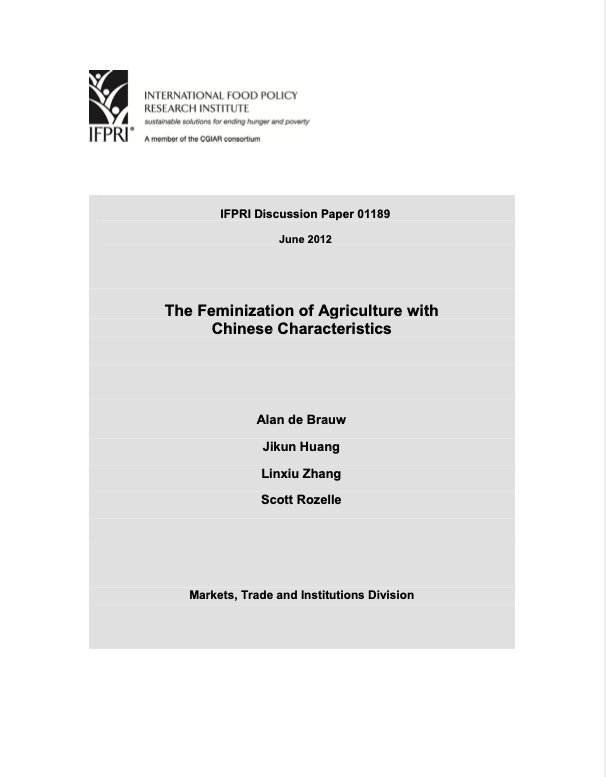The Feminization of Agriculture with Chinese Characteristics
The objectives of this paper are to help build a picture of the role of women in China’s agriculture, to assess whether or not agricultural feminization has been occurring, and if so, to measure its impact on productivity. To meet these goals, we rely on three datasets that allow us to explore who is working on China’s farms and the effects of the labor allocation decisions of rural households on productivity. We find that since 2000, the role of women has increased both in the supply of farm labor and in the duties that women take on in the management of farms.
Strategies for Sustainable Land Management in the East African Highlands: Conclusions and Implications
The studies in this book sought to understand the factors affecting rural households’ choice of income strategies and land management practices and the implications of these decisions and of policy- and program-relevant factors for agricultural production, household welfare, and land degradation. We noted at the outset that the factors influencing these decisions and outcomes are many and complex and that their effects may be very context-dependent in a region as diverse as the East African highlands. The findings in the preceding chapters amply support this hypothesis.
Influences of Programs and Organizations on the Adoption of Sustainable Land Management Technologies in Uganda
Governments are devolving service and infrastructure provision, regulatory authority, and decisionmaking in many developing countries. Market reforms and structural adjustment policies devolve the provision of services and infrastructure to nongovernmental organizations (NGOs), community-based organizations (CBOs), and the private sector (Farrington and Bebbington 1993; Uphoff 1993; Pender and Scherr 2002).
Collective action and property rights for sustainable development
Institutions of collective action and systems of property rights shape how people use natural resources, and these patterns of use in turn affect the outcomes of people’s agricultural production systems. Together, mechanisms of collective action and property rights define the incentives people face for undertaking sustainable and productive management strategies, and they affect the level and distribution of benefits from natural resources.
East African agriculture and climate change: A comprehensive analysis
The second of three books in IFPRI's climate change in Africa series, East African Agriculture and Climate Change: A Comprehensive Analysis examines the food security threats facing 10 of the countries that make up east and central Africa - Burundi, Democratic Republic of Congo, Eritrea, Kenya, Madagascar, Rwanda, Sudan, Tanzania, and Uganda - and explores how climate change will increase the efforts needed to achieve sustainable food security throughout the region. East Africa's populations is expected to grow at least through mid-century. The region will also see income growth.
Conceptual Framework and Hypotheses
In this chapter we introduce the conceptual framework that underlies the case studies presented in this book and discuss hypotheses about the effects of key factors on community and household decisions concerning income strategies and land management. We also discuss the influence of such decisions on outcomes such as agricultural production, household income, and land degradation (or improvement). This chapter is adapted from Scherr et al. (1996); Pender, Place, and Ehui (1999); Pender, Scherr, and Durón (2001); and Nkonya et al. (2004).
Accessing international markets: Ports and portsheds
More than 300 million Africans, about 30 percent of the total population, live more than one day away from the nearest port. Even when ports lie within a few hundred miles, typically sparse road networks, poor maintenance, and limited transportation infrastructure translate into high access costs. The larger map illustrates cost-of-travel accessibility to 63 major African ports, based on port type, size, and capacity in terms of the estimated total number of hours, both off and on the road network, required to travel from any location in Africa to the nearest port.
2012 Annual Report
Agricultural commercialization, economic development, and nutrition
A large body of literature makes the argument that commercialization of agriculture has mainly negative effects on the employment, incomes, food production and consumption, health, and nutrition of the poor. In Commercialization of Agriculture, Economic Development, and Nutrition, Joachim von Braun and Eileen Kennedy find that the conclusion that commercialization of agriculture is generally bad for nutrition is flawed.
Public agriculture R&D investments
Book chapter
The business imperative: Helping small family farmers to move up or move out
How can family farmers best contribute to their country’s agriculture needs as well as broader development goals? First, we should determine which farmers can be profitable and assist them in doing so. Second, for those who aren’t profitable, we need to help them shift to other economic pursuits.








